When roasting spices outdoors, you'll control heat intensity through multiple factors. Your equipment choice, like gas-operated roasters or solar setups, provides the foundation for heat management. You can adjust burner settings, fan speeds, and reflector positions to fine-tune temperature levels. Weather conditions, including sun intensity and wind patterns, will affect your heat control strategy. The size of your spice batch matters too – larger amounts need more heat adjustment for even roasting. Your choice of roasting container material (brass, stainless steel, or plastic) also impacts heat distribution. Understanding these elements will help you master the art of outdoor spice roasting.
Equipment Selection and Setup
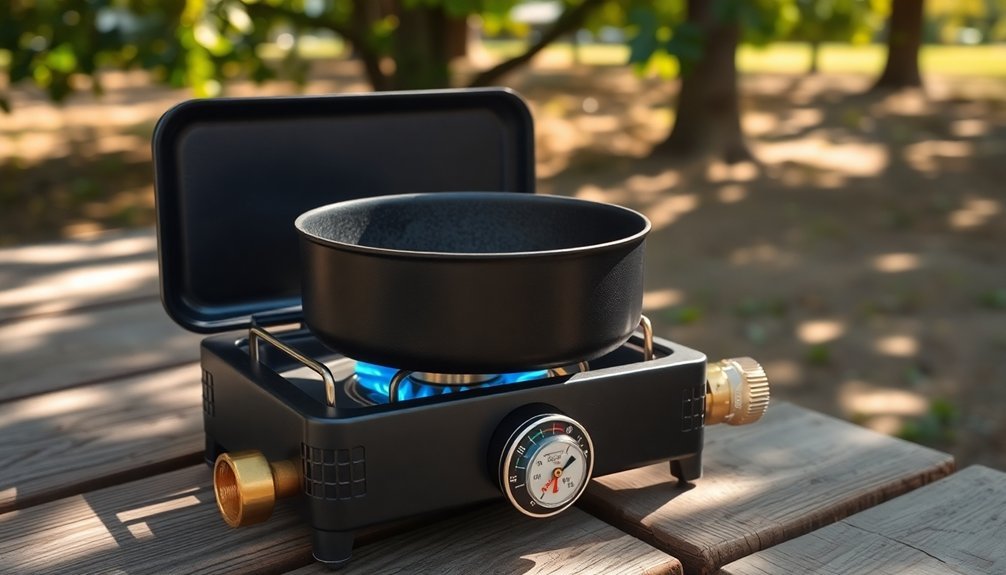
When setting up outdoor spice roasting equipment, selecting the right combination of tools and machinery greatly impacts your results.
You'll want to focus on gas-operated roasters, as they're typically more portable and efficient for outdoor use. Look for models with propane burners rated around 57,000 BTU's that include safety shut-off valves. The ability to function as a coating pan without heat makes these roasters even more versatile.
Choose a rotary drum roaster made from SS 304 material, as it provides even heat distribution and durability in outdoor conditions. The drum size should match your batch requirements – sizes range from 25 to 1000 litres.
Make sure your setup includes proper thermal insulation and digital controls to maintain consistent temperatures. Don't forget to check that all safety switches are functioning and the pre-wired control panel is protected from outdoor elements.
Solar Position and Weather Factors
Since outdoor spice roasting relies heavily on environmental conditions, understanding solar position and weather factors is essential for achieving consistent results.
You'll need to account for the sun's intensity, which can reach temperatures up to 840°F in ideal conditions, and consider your location's available sunshine days. Research has shown that solar roasting temperatures can exceed 900°F when properly concentrated.
Weather conditions directly impact your roasting success:
- Cold temperatures slow down the roasting process by affecting both your equipment and spices, requiring longer roasting times.
- High humidity accelerates moisture loss and heat transfer, making your spices roast faster than expected.
- Atmospheric pressure changes can alter airflow patterns, affecting how evenly your spices roast.
To maintain consistency, you'll want to track these variables and adjust your roasting technique accordingly.
Using heliostats can help compensate for less-than-ideal sun positions and provide more uniform heat distribution.
Batch Size Impact
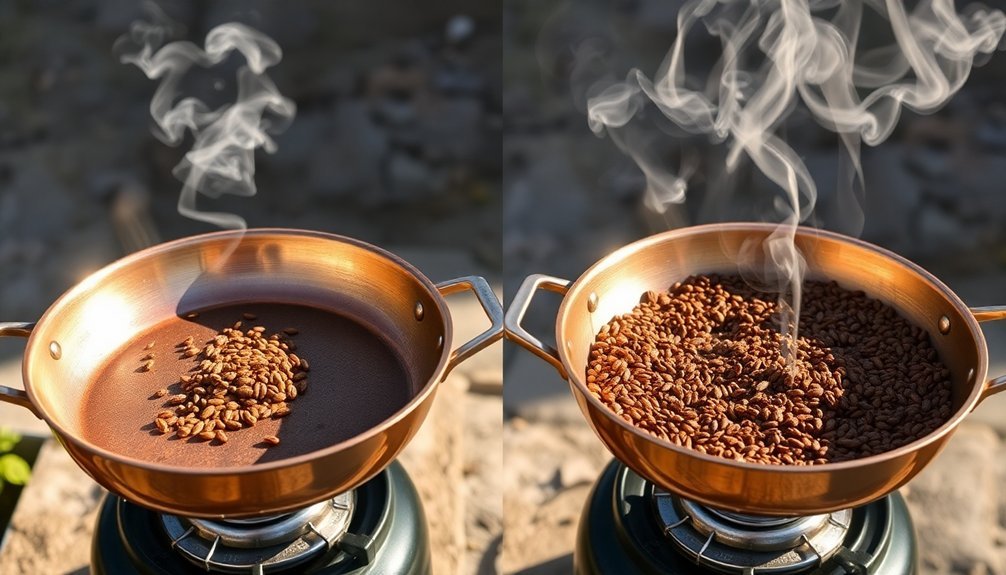
When you're working with larger batches of spices outdoors, you'll need considerably more heat to achieve even roasting throughout the entire load.
Your spice load size directly affects how quickly the batch reaches ideal roasting temperature, with larger quantities requiring more time and heat intensity.
Managing temperature control becomes more critical with bigger batches, as uneven heat distribution can result in inconsistent roasting across your spices. Experts recommend maintaining between 25% to 80% capacity of your roasting vessel for optimal results.
Controlling Large Batch Heat
Because larger spice batches absorb heat differently, they require careful adjustments to your roasting approach. You'll need to increase your heat temperature by up to 10 degrees C for each additional kilo to guarantee proper distribution throughout the batch.
Similar to coffee roasting where larger batch sizes typically reach higher first crack temperatures, spices also demonstrate this heat absorption pattern. Remember that the outside of your spices will roast faster than the inside when working with larger quantities.
To maintain control over large batch heat:
- Don't exceed 80% of your roasting vessel's capacity to prevent uneven heating and potential burning.
- Reduce your power settings during the latter part of the roast to achieve ideal results.
- Adjust your heat-up protocol based on your specific batch size and roasting equipment.
Keep in mind that you'll need to modify both airflow and heat input throughout the process to achieve consistent results across your entire batch.
Load Size Affects Temperature
Load size plays an essential role in determining your roasting temperature requirements. When you're working with larger batches, you'll need higher temperatures and more energy to achieve proper heat distribution through conduction, convection, and radiation. You'll also need to adjust your burner settings accordingly.
Smaller loads roast faster but require more frequent sessions, while larger batches take longer and need extended cooling periods. If you're seeking greater control over your roast profile, consider reducing your batch size.
However, remember that consistency is key – sticking to fixed batch sizes helps you maintain reliable results and makes it easier to fine-tune other parameters. Be mindful that larger loads create more chaff buildup and can increase wear on your equipment, so you'll need to adjust your maintenance schedule accordingly.
Reflector Management
The success of outdoor spice roasting largely depends on proper reflector management, which combines strategic positioning and material maintenance.
You'll need to align your reflectors carefully to capture maximum sunlight while guaranteeing even heat distribution across your roasting container.
Maintain ideal heat control by following these essential steps:
- Position your parabolic troughs or segmented glass mirrors to track the sun's movement, adjusting angles throughout the day.
- Keep your reflective surfaces clean and free from dust or debris that could reduce efficiency.
- Rotate your spice container periodically to prevent hot spots and guarantee uniform roasting.
For best results, use durable materials like aluminum or glass reflectors that can withstand high temperatures.
If you're using a foldable design, check the mounting stability regularly to prevent misalignment that could affect your roasting temperature.
Temperature Control Methods
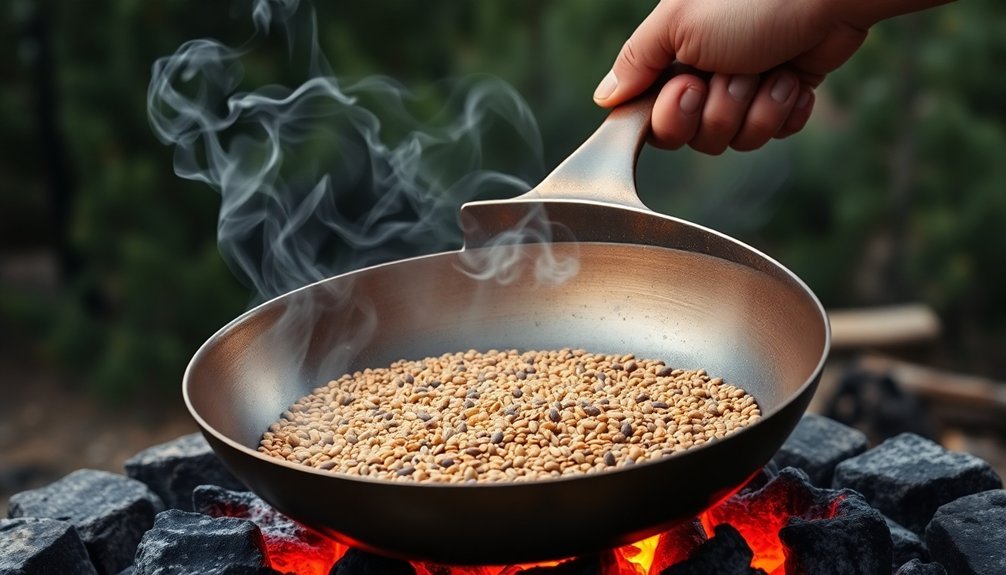
You'll get better control over your spice roasting by managing the inlet temperature through vent adjustments and proper coal placement in your outdoor setup.
Control fan speeds, if your equipment has them, to regulate airflow and maintain consistent heat levels for even spice roasting.
For precise temperature management, you can adjust your equipment's power settings while monitoring the heat to prevent scorching your spices.
Inlet Temperature Adjustments
When roasting spices outdoors, maintaining precise heat control begins with proper inlet temperature adjustments.
You'll need to monitor and adjust your heat source's inlet temperature to achieve consistent results, much like professional coffee roasters do. This helps stabilize the roasting environment despite outdoor variables like wind and ambient temperature changes.
To effectively manage inlet temperatures when roasting spices outdoors:
- Monitor your heat source's inlet temperature using a reliable temperature sensor for precise control.
- Adjust power levels up or down to maintain your target inlet temperature, especially when weather conditions change.
- Keep exhaust settings balanced to maintain positive-to-neutral pressure during the roasting process.
Fan Speed Control Methods
Properly controlling fan speed represents a critical aspect of outdoor spice roasting, requiring both manual adjustments and temperature-dependent monitoring systems.
You'll need to adjust fan speeds based on your batch size, with smaller batches (around 325g) working well at F2-F3 settings, while larger batches may need different configurations.
To maintain ideal roasting conditions, you can use temperature sensors that provide feedback for automated fan control. This helps you keep consistent temperatures despite outdoor weather variations.
You'll want to monitor drum pressure using a manometer, aiming for positive-to-neutral pressure early in the roast and negative pressure at crack.
For precise control, you can implement variable resistors or capacitors to achieve specific fan speed increments, and use PWM controllers for accurate AC fan speed adjustments.
Equipment Power Management
Building on effective fan control, successful temperature management requires a thorough approach to equipment power settings and heat source control.
You'll need to monitor temperatures precisely using thermocouples and digital displays while managing your heat source effectively.
For ideal power management when roasting spices outdoors:
- Set up your roasting monitor with a portable battery, ensuring it's positioned to capture real-time temperature data while staying protected from heat.
- Install wired thermometers at key points in your cooking vessel, connecting them to automatic control valves that'll regulate heat based on temperature changes.
- Keep output temperatures below 85-95°F by adjusting your coal arrangement in a 3:1 ratio (top to bottom), and use your temperature monitoring system to make immediate adjustments when needed.
Roasting Container Materials
The choice of roasting container material can greatly impact your spice roasting success and the longevity of your spices. When roasting outdoors, you'll want to contemplate durability, heat retention, and health implications of your container material.
| Feature | Brass | Stainless Steel | Plastic |
|---|---|---|---|
| Health | Antimicrobial, preserves oils | Non-reactive | Can leach chemicals |
| Durability | Lasts generations | Highly durable | Prone to damage |
| Maintenance | Needs regular polishing | Easy to clean | Minimal care needed |
| Best Use | Traditional roasting | Modern cooking | Short-term storage |
Brass offers traditional benefits with its antimicrobial properties and ability to preserve aromatic oils, though it requires more maintenance. Stainless steel provides a practical, low-maintenance option that's ideal for modern outdoor cooking. While plastic is affordable, it's best avoided for roasting due to potential chemical leaching and poor heat handling.
Ventilation and Heat Distribution
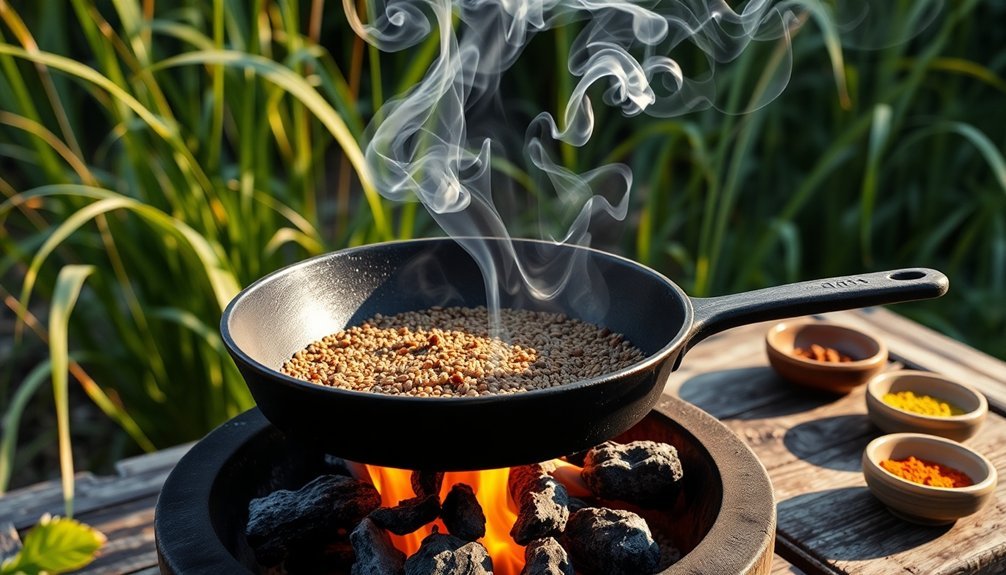
Mastering ventilation and heat distribution creates the foundation for successful outdoor spice roasting.
You'll need to control airflow to maintain consistent heat while guaranteeing your spices roast evenly. When roasting outdoors, proper ventilation helps extract moisture and distribute heat uniformly across your spices, similar to professional coffee roasting techniques.
To achieve ideal results, follow these key steps:
- Spread your spices in a single, even layer on your roasting surface to guarantee each piece receives equal heat exposure.
- Adjust airflow by positioning your setup to take advantage of natural wind patterns while protecting against gusts that could blow spices away.
- Stir continuously and watch for visual cues – the spices should darken gradually and release their aromatics without burning.
Keep monitoring the process closely, as outdoor conditions can affect roasting times considerably.
Frequently Asked Questions
How Do Different Spice Oils Affect Heat Retention During Outdoor Roasting?
You'll find volatile oils evaporate quickly while non-volatile oils retain heat longer during roasting. Your spices with higher oil content need gentler heating, as they'll hold and distribute temperature more effectively throughout cooking.
Can Volcanic Rocks Enhance Heat Distribution for Outdoor Spice Roasting?
Yes, you'll find volcanic rocks excellent for spice roasting. They'll distribute heat evenly, maintain consistent temperatures, and prevent hot spots. You can rely on their long-lasting heat retention for better control while roasting.
What Role Does Ground Surface Material Play in Heat Reflection?
Your ground surface material greatly impacts heat reflection – lighter, reflective surfaces bounce heat upward, while darker materials absorb it. This'll affect how much heat reaches your spices during the roasting process.
Does Moonlight Reflection Impact Nighttime Outdoor Spice Roasting Temperatures?
No, moonlight reflection won't affect your spice roasting temperatures at night. You'll only need to focus on your ambient air temperature, roasting method, and proper heat management while preparing your spices outdoors.
How Do Nearby Buildings Affect Wind Patterns During Outdoor Roasting?
You'll find that tall buildings create unpredictable wind turbulence and swirling patterns around your roasting setup. They'll force air up and down, potentially disrupting your flame and heat control during outdoor spice roasting.
In Summary
You'll find that successful outdoor spice roasting depends on multiple factors working together. Managing your heat source, choosing appropriate containers, and responding to weather conditions are key. Whether you're using solar or flame-based methods, you'll need to adjust reflectors, control ventilation, and monitor batch sizes carefully. With practice, you'll master the balance between equipment, environment, and technique for perfect spice roasting.

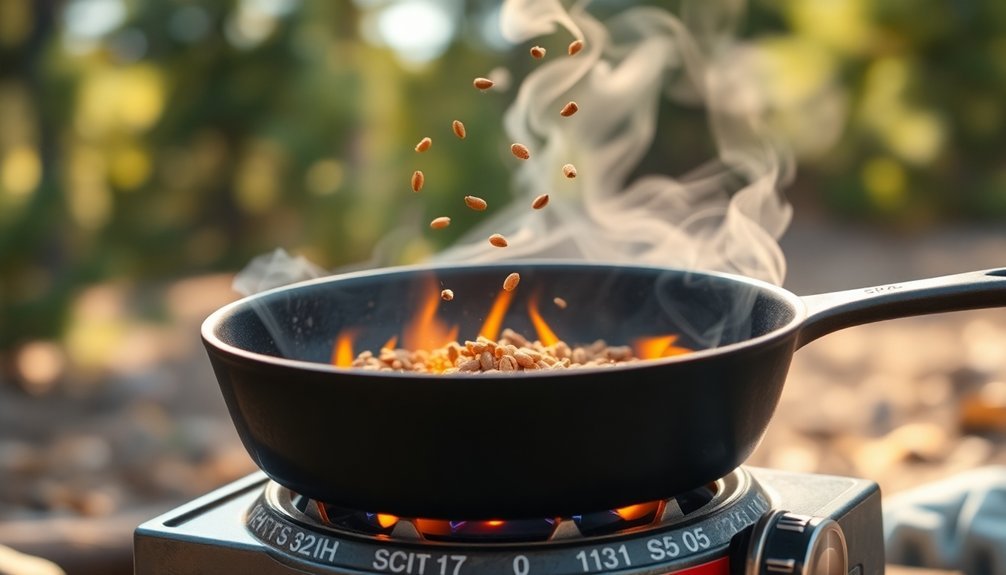



Leave a Reply